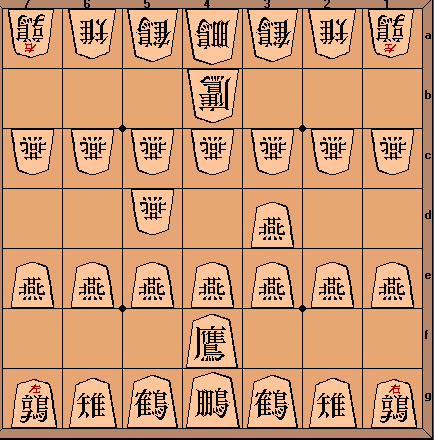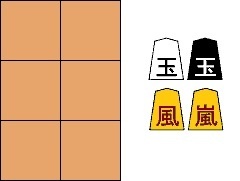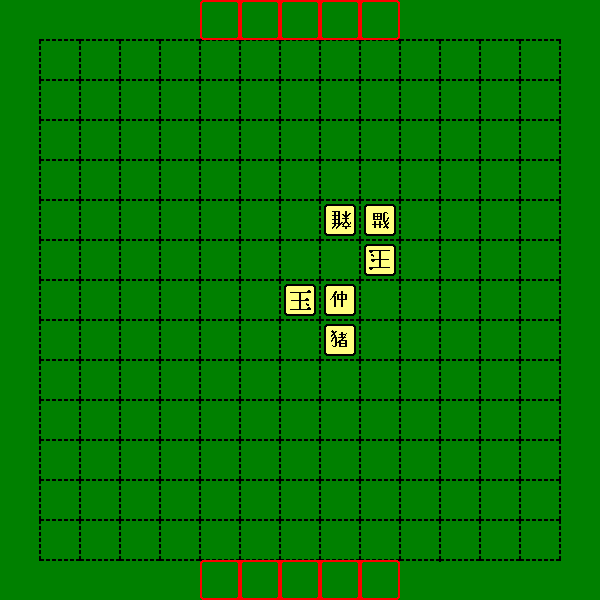^Reading about Railroad Tycoon, it looks like a fun game. Perhaps one day I'll be able to give it a try. I enjoy that sort of game, including the simple fact that one learns history and geography while playing, two subjects I really enjoy. Thanks for the recommendation. I'll let you know if I ever get the chance to play it :)
Well, I think it's time to discuss a few more small shogi variants, then perhaps mention a larger one or two.
Let's start with one of the larger small variants: Tori shogi

I find it truly odd that the article I link to claims that this is the smallest variant in the shogi family, as it is 7x7, so there are several smaller. Nevertheless, I hear it is considered among the best of the variants, and it has a rather loyal following. It looks interesting to me, but I'll admit that though I've tried most of the others, I've never really given this one a shot. I think this is mostly because I've favored the smallest variants for their speed, except in the case of the original game. However, I hope to give this a try now that I've got a regular shogi partner.
Dobutsu shogi is a unique variant that I've only recently learned about.

This 3x4 variant is sold commercially, and was invented by a Japanese female shogi master hoping to attract more children, especially girls, to shogi in general. The piece moves are clearly printed there with the cute little animal illustrations, so you can see how weak the pieces are. This is of course a good thing for games in such close quarters. I can't imagine any possible way to checkmate the opposing lion (king) without your two of your pieces pressed against him and your lion providing support. Looks fun, and I believe it'd be worth a try as well.
Nana shogi is a very tiny variant, using only 9 squares at 3x3.

There are two versions, one with stronger pieces, and one with two pieces weakened (which should have been renamed considering their new moves and that there are other pre-existing with identical moves, but I digress). The weaker pieces make the game more even, as the first player has a big advantage. This game is substantially different than other shogi variants for a number of reasons. For one thing, like Kyoto shogi, pieces alternate their value with each move. But instead of promoting/demoting between two faces, all the pieces are cubes and alternate between 4 different piece values. This makes it exceedingly difficult for mere mortals to remember what will follow after one moves a piece. Another difference is that the board starts empty and that the first moves are simply drops as players introduce their pieces into the game. It's a hard game to play well, but it is certainly no simplistic game in spite of its size.
Gufuu shogi, invented by the same man as above, is barely still a shogi game in my mind. However, it does still utilize drops and the basic premise of checkmate, so I suppose one could still consider it shogi, as different as it is. It is merely a 2x3 game with two kings and two shared pieces. Like Nana shogi, the board starts empty.

Players take turns playing those pieces, and only when checking your opponent's king does the checking piece remain yours. Pieces here go back to being flat, and they don't even promote. But they do rotate, so the direction of their attack changes. The same goes for the kings. They actually can be next to each other (without capturing), and only cannot when when one's forward (top, north, what's the right term?) side is facing the opposing king. It's so different, a truly unique variant, perhaps very enjoyable, but only slightly still a shogi game.
There is one more game by the above inventor, a 1x2 game he calls Bushi shogi. It is simply two cubes rotating and having their orientation act as attacks and defenses. While it sounds like an interesting game, I simply do not see it as a shogi game. I mention it here for completion's sake, but I do not see a point in describing it. It simply isn't shogi.
There are other small games, but for now I'll hold on to those. I do want to mention a game of indeterminate size because I think it's important to note its relationship with Nana shogi. It is called Ki shogi, another game played with cubic pieces that alternate between faces. Only this time there are six, not just four values per cube. The promotion rules are pretty complex, but what I really like about this game is that the playable area is determined by the positions of the two kings. One plays on a table of any size and imagines the grid, but really the edge of the game's playable area usually does not come anywhere near the edge of the table. It just matters how players move their pieces with respect to each other. Really a novel concept. The following image shows grid lines, though they are really not necessary when playing.

Well, that's all for now. I love shogi and its endless variations!